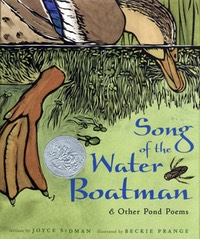 |
| Image courtesy Joyce Sidman |
Joyce Sidman’s Song of the Water Boatman & Other Pond Poems is a collection of 11 poems that explore the ecosystem of a pond from the beginning of spring through the onset of winter. The poems are a combination of forms including rhyming poems, free verse poems, and shape poems. Each poem is accompanied by a beautiful ¾ to full page woodblock illustration hand-colored with watercolor and a short paragraph that provides information about the organism depicted in the poem.
The language Sidman uses make the poems accessible for young children. The poems themselves use imagery and concrete language to explain the habitat and behavior of unfamiliar animals and plants in a way that is understandable for children. For example, in “Listen for Me” the arrival of the spring peepers is described from the point of view of one of the frogs saying, “I creep up from the cold pond/the ice pond,/the winter pond.” Any academic or technical vocabulary such as “herbivorous” and “carnivorous” is reserved for the sidebars where the terms are first explained and included in parentheses. Young readers can enjoy the poems and learn important vocabulary words without difficult language getting in the way of the poems.
Sidman uses several different repetition and rhythm to create patterns throughout the poems in Song of the Water Boatman & Other Pond Poems. For example, in “Listen for Me” Sidman repeats the last word at the end of the first four lines of each stanza. The repetition is extended to a refrain in “Song of the Water Boatman and Backswimmer’s Refrain” where each stanza ends with a variation of the refrain “Yo, ho, ho,/the pond winds blow.” The various forms of repetition provide ample opportunities for choral reading and performance.
Song of the Water Boatman & Other Pond Poems is a 2006 Caldecott Honor Book and an excellent resource to use in support of a wide variety of science concepts.
Example Poem
In the Depths of the Summer Pond
Here hang the algae, green and small,
in the depths of the summer pond.
Here floats the flea, waving antennae,
that eats the algae, green and small,
in the depths of the summer pond.
Here nods the nymph with feathery gills
that drinks the flea,
that eats the algae, green and small,
in the depths of the summer pond.
Here dives the bug, sleek and swift,
that nabs the nymph
that drinks the flea
that eats the algae, green and small,
in the depths of the summer pond.
Here kicks the frog with golden eyes
that gulps the bug,
that nabs the nymph
that drinks the flea
that eats the algae, green and small,
in the depths of the summer pond.
Here lurks the fish, wide of jaw,
that swallows the frog
that gulps the bug,
that nabs the nymph
that drinks the flea
that eats the algae, green and small,
in the depths of the summer pond.
Here hunts the heron, queen of the pond,
that spears the fish,
that swallows the frog
that gulps the bug,
that nabs the nymph
that drinks the flea
that eats the algae, green and small,
in the depths of the summer pond.
Activity
“In the Depths of the Summer Pond” is a great poem to use with students who are studying the food chain in their science classes. Begin by asking students what they know about food chains and food webs. Have them explain key vocabulary like consumers, producers, and decomposers. Then explain that you will be reading a poems that explores a food chain in a specific ecosystem--a pond during the summertime.
Read through the poem once or twice for students to model pronunciation of words and the rhythm. Children of all ages will pick up the repetition of the the lines “that eats the algae, green and small,/in the depths of the summer pond” and will likely join in after the first few stanzas. Once students have a feel for the rhythm, divide the students into seven groups (or select seven readers). Assign each group one of the animals, and allow them time to practice their parts. Then have the groups read the lines about their animal in each stanza, with everyone chiming in for the line “in the depths of the summer pond.”
As an extension, give the students another ecosystem--the ocean, the rainforest, the woods, or the desert--and ask them to identify seven parts of a food chain for that ecosystem. Working with their group members, students could then produce an illustration or find a public domain or Creative Commons digital image online and write a line of poetry to describe their animal. All the images and lines can be put together on the wall or in photo editing software to make a food chain diagram.

